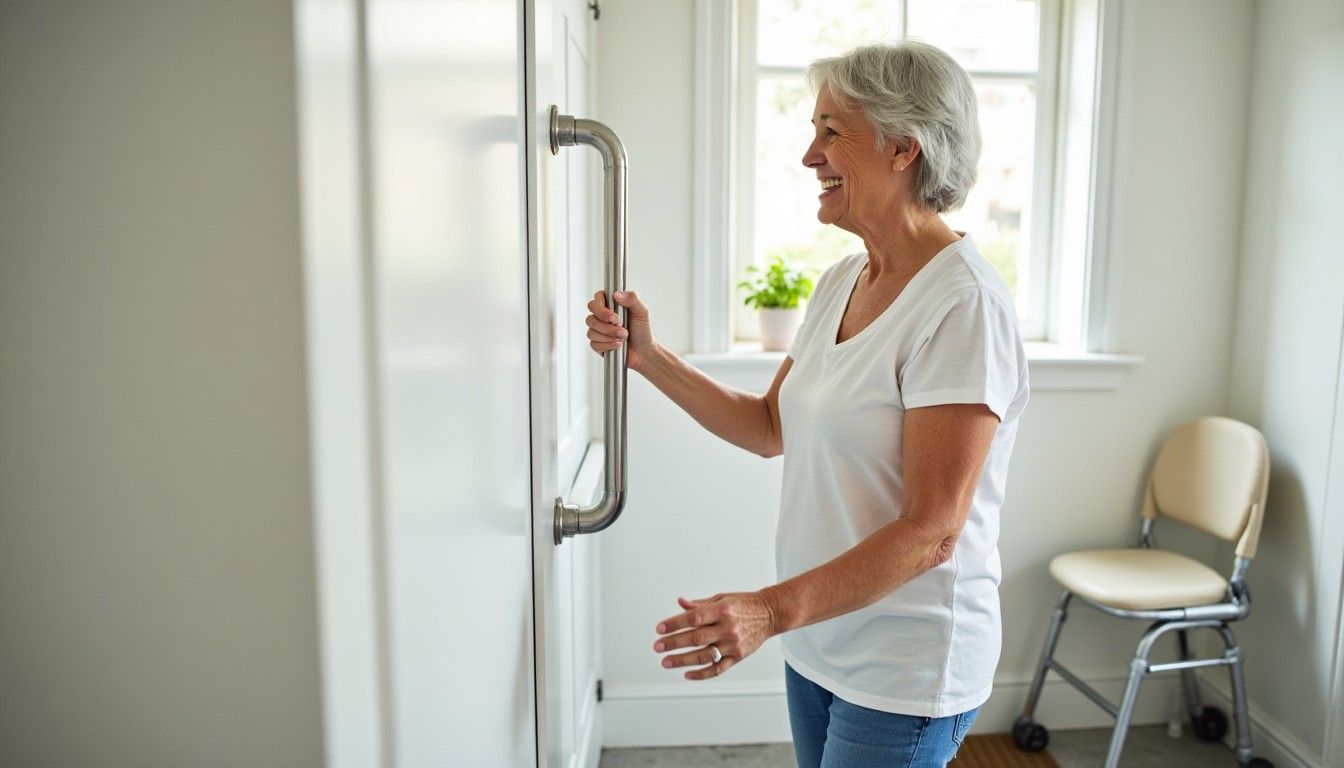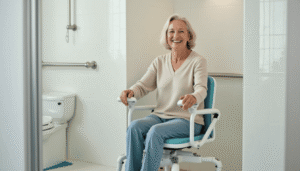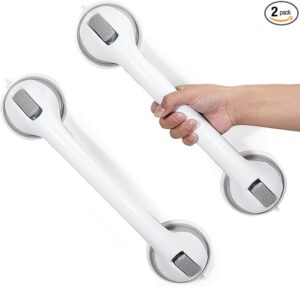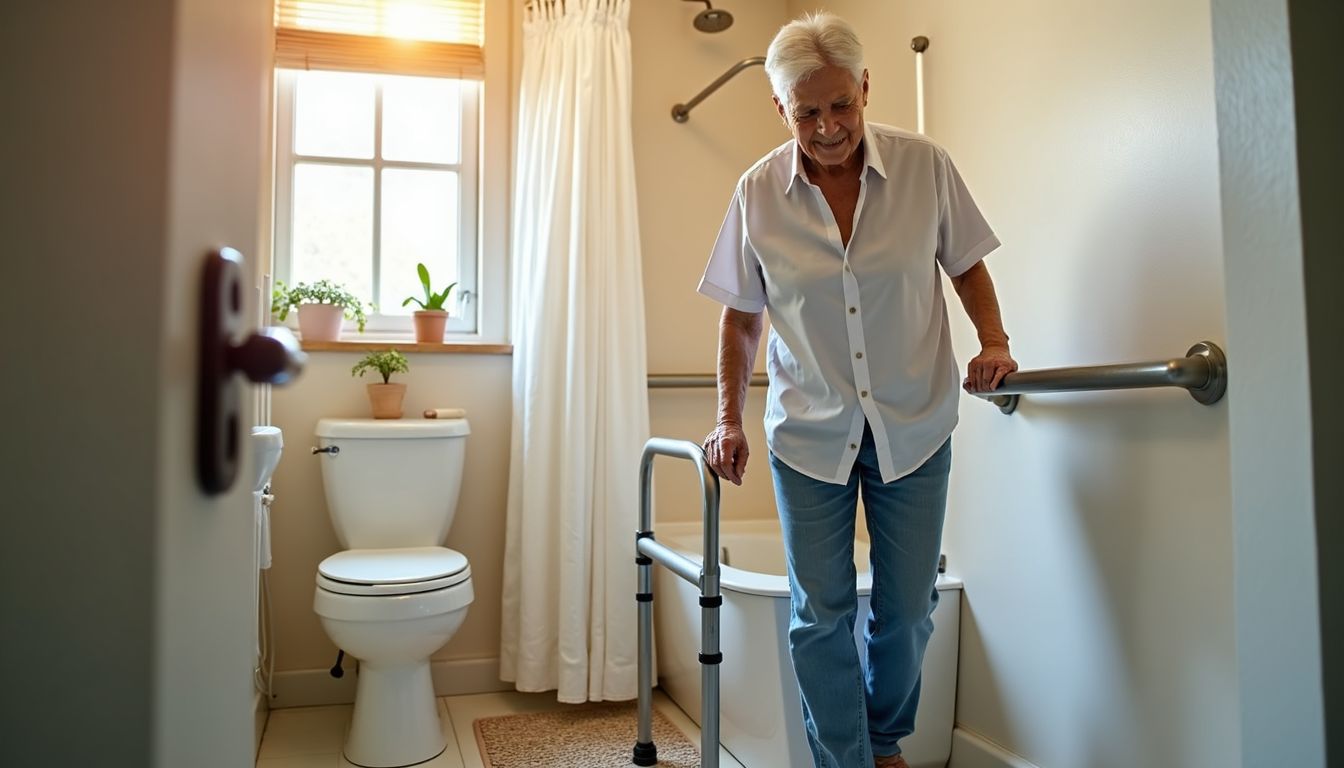1. Introduction
Staying safe in the bathroom is one of the most important yet often overlooked parts of senior health. For many elderly people, something as simple as taking a shower can become risky. Slippery floors, wet surfaces, and limited mobility can quickly turn a daily routine into a dangerous situation.
That’s why shower safety for the elderly is so important. A few small adjustments and precautions can make a huge difference — reducing the risk of falls, preventing injuries, and helping seniors stay independent longer.
In this blog, we’ll share practical tips, step-by-step guidance, and recommended products to make showers safer for seniors. Whether it’s installing grab bars, using non-slip mats, or choosing the right shower chair, these simple changes can help every senior feel confident and secure in the bathroom.
2. Why Shower Safety is Crucial for Seniors
Bathrooms are one of the most common places for accidents among seniors. In fact, studies show that a large percentage of falls in older adults happen in the bathroom, often while getting in or out of the shower. These accidents can lead to serious injuries, including broken bones, head trauma, or long hospital stays.
As we age, our balance, strength, and reflexes naturally decline. Even simple tasks like stepping into a shower or reaching for soap can become risky. Wet surfaces, slippery tiles, and inadequate support make these everyday movements more dangerous.
Focusing on shower safety for the elderly is not just about preventing injuries — it’s about maintaining independence. When seniors feel safe and secure in their bathrooms, they can continue taking care of themselves without relying heavily on caregivers.
Small precautions can make a big difference: from adding grab bars and non-slip mats to using shower chairs or handheld showerheads. Implementing these changes helps seniors stay confident, reduces the risk of falls, and ensures that a daily shower remains a safe and comfortable part of life.
3. Common Risks in the Shower for Elderly People
Even a small slip in the shower can have serious consequences for seniors. Understanding the most common risks is the first step toward making the bathroom safer. Here are some key hazards to watch out for:
-
Slippery Floors – Wet tiles or soap residue can easily cause falls. Even a tiny amount of water can be dangerous for seniors with reduced balance.
-
Lack of Support – Showers without grab bars or handrails force seniors to rely on their own strength, increasing the risk of slips or overbalancing.
-
Difficulty Stepping In or Out – High shower or bathtub edges make entry and exit tricky, especially for seniors with weak legs or limited mobility.
-
Limited Visibility or Poor Lighting – Dimly lit bathrooms make it harder to see wet spots, soap, or obstacles, leading to accidental slips.
-
Hot Water Burns – Sudden changes in water temperature can cause burns or startle a senior, increasing the chance of falling.
By knowing these risks, seniors and caregivers can take proactive steps to reduce hazards and improve shower safety for the elderly. In the next section, we’ll cover simple, effective tips to make showers safer and more comfortable for seniors.
4. Essential Shower Safety Tips for the Elderly
Making a shower safe for seniors doesn’t have to be complicated. With a few simple changes and tools, you can prevent slips, falls, and injuries. Here are the most effective tips for shower safety for the elderly:
-
Install Grab Bars and Handrails
Grab bars provide support when entering, exiting, or moving around in the shower. Place them near the shower entrance, along walls, and next to the toilet for maximum safety. -
Use Non-Slip Mats
A sturdy, non-slip mat on the shower floor can prevent accidental slips. Make sure it stays flat and is replaced if it wears out. -
Consider a Shower Chair or Bench
For seniors who have trouble standing for long periods, a shower chair or bench offers stability and comfort. It allows them to sit while bathing safely. -
Use a Handheld Showerhead
A handheld showerhead makes it easier to reach all areas without stretching or twisting, reducing the risk of losing balance. -
Install Anti-Scald Devices
Temperature fluctuations can be dangerous. Anti-scald devices prevent sudden hot water bursts, keeping showers safe and comfortable. -
Keep Toiletries Within Reach
Place soap, shampoo, and other essentials at an accessible height. This prevents overreaching, bending, or twisting, which can lead to slips.
By applying these simple tips, seniors can enjoy showers without fear of falling. Small adjustments like grab bars, non-slip mats, and handheld showerheads make a huge difference in daily safety and independence.
5. Step-by-Step Guide to Making a Shower Safe
Improving shower safety for the elderly can be simple if you follow a few practical steps. Here’s a step-by-step guide to transform any bathroom into a safer space:
Step 1: Assess the Bathroom for Hazards
-
Walk through the shower and bathroom area.
-
Check for slippery tiles, clutter, poor lighting, and high tub edges.
-
Note any areas where support may be needed.
Step 2: Plan the Layout for Safety
-
Decide where to place grab bars and handrails for maximum support.
-
Identify spots for non-slip mats and shower chairs.
-
Ensure toiletries are within easy reach to avoid bending or stretching.
Step 3: Install Grab Bars and Handrails Properly
-
Use wall studs for secure installation.
-
Place one near the shower entrance and another along the wall inside the shower.
-
Add bars near the toilet for extra support.
Step 4: Add Non-Slip Mats and Shower Chairs
-
Place a non-slip mat on the shower floor and outside for safe entry/exit.
-
Position a shower chair or bench for seniors who need to sit while bathing.
Step 5: Set Up Handheld Showerhead and Anti-Scald Devices
-
Install a handheld showerhead for easier control and safer bathing.
-
Use anti-scald devices to prevent sudden hot water bursts.
Step 6: Test and Adjust
-
Have the senior try the shower with all safety modifications.
-
Make adjustments to bars, mats, or chair placement as needed.
By following these steps, you create a safer, more comfortable environment for seniors. Simple modifications can dramatically reduce the risk of falls and help maintain independence in daily life.
6. Recommended Products for Shower Safety (Affiliate Section)
Using the right tools can make a huge difference in shower safety for the elderly. Here are some highly recommended products that help seniors stay safe, comfortable, and independent:
-
Shower Chairs & Benches
-
Ideal for seniors who have trouble standing for long periods.
-
Provides stability and comfort while bathing.
-
Look for chairs with non-slip feet and back support.
-
Non-Slip Mats
-
Essential for preventing slips in wet areas.
-
Choose mats with strong suction cups or textured surfaces for extra grip.
-
Grab Bars & Rails
-
Install near the shower entrance, along the walls, and next to the toilet.
-
Make sure they are securely anchored into wall studs.
-
Handheld Showerheads
-
Makes it easier to control water direction without twisting or stretching.
-
Adjustable lengths allow seniors to wash safely while seated.
-
Bath Safety Rails
-
Assist with stepping in and out of the tub.
-
Provides extra support for seniors with limited leg strength.
-
Anti-Scald Devices
-
Prevent sudden temperature changes.
-
Ensure a safe and comfortable shower every time.
✅ These simple products can dramatically improve shower safety for the elderly, reduce the risk of falls, and make bathing a stress-free experience.
7. Tips for Daily Use & Maintenance
Even the safest shower setup needs a little care to stay effective. Here are some practical tips to ensure shower safety for the elderly every day:
-
Clean Mats and Bars Regularly
-
Soap residue and water buildup can make mats slippery.
-
Wipe down grab bars and rails to keep them free from grime.
-
Check for Wear and Tear
-
Inspect non-slip mats, shower chairs, and grab bars frequently.
-
Replace anything that is worn, loose, or damaged to prevent accidents.
-
Encourage Consistent Use
-
Remind seniors to always use grab bars and sit on chairs if needed.
-
Consistent use of safety equipment helps reduce fall risks.
-
Keep Essentials Accessible
-
Make sure soap, shampoo, towels, and other items are easy to reach.
-
Avoid bending, stretching, or leaning while standing in the shower.
-
Adjust Lighting as Needed
-
Ensure the shower area is well-lit, especially in the mornings or evenings.
-
Motion-sensor night lights can help prevent trips during nighttime bathroom visits.
By following these tips, seniors can enjoy a safer, more comfortable shower experience every day. Maintaining equipment and good habits is just as important as installing the safety tools themselves.
8. FAQs About Shower Safety for Seniors
1. How can seniors prevent slips in the shower?
Seniors can prevent slips by using grab bars, non-slip mats, and shower chairs. Installing proper lighting and keeping toiletries within reach also reduces the risk of accidents.
2. Are shower chairs safe for all elderly people?
Yes, shower chairs are generally safe for seniors, especially those with limited mobility or balance issues. Make sure the chair is sturdy, has non-slip feet, and is placed correctly in the shower.
3. What’s the best way to install grab bars?
Grab bars should be securely anchored into wall studs, not just the tile. Place them near the shower entrance, along the shower wall, and next to the toilet for maximum support.
4. Can small bathroom modifications really reduce fall risks?
Absolutely. Simple changes like grab bars, non-slip mats, handheld showerheads, and proper lighting can dramatically reduce the risk of falls and make showers much safer for seniors.
5. Are anti-scald devices necessary for elderly showers?
Yes. Anti-scald devices prevent sudden hot water bursts, which can startle seniors or cause burns, reducing the chance of slips and injuries.
6. How often should shower safety equipment be checked?
Inspect mats, grab bars, and chairs at least once a month. Replace or repair anything that is worn, loose, or damaged to maintain a safe shower environment.
9. Conclusion
Keeping seniors safe in the bathroom doesn’t have to be complicated. By focusing on shower safety for the elderly, small changes can prevent falls, reduce injuries, and allow seniors to maintain their independence.
From installing grab bars and non-slip mats to using shower chairs and handheld showerheads, simple adjustments make a huge difference. Regular maintenance, good habits, and the right safety products ensure that showers remain safe and comfortable every day.
Remember, the goal isn’t just to prevent accidents — it’s to help seniors feel confident, secure, and independent while taking care of themselves.
Shower safety for the elderly is crucial to prevent falls in one of the most hazardous areas of the home. Installing bathroom grab bars for elderly, using non-slip bathroom mats, and adding a swivel shower chair for elderly can significantly reduce risks. For seniors who want to maintain mobility and strength, incorporating 10 Easy Mobility Exercises for Seniors into daily routines also helps improve balance and stability.







